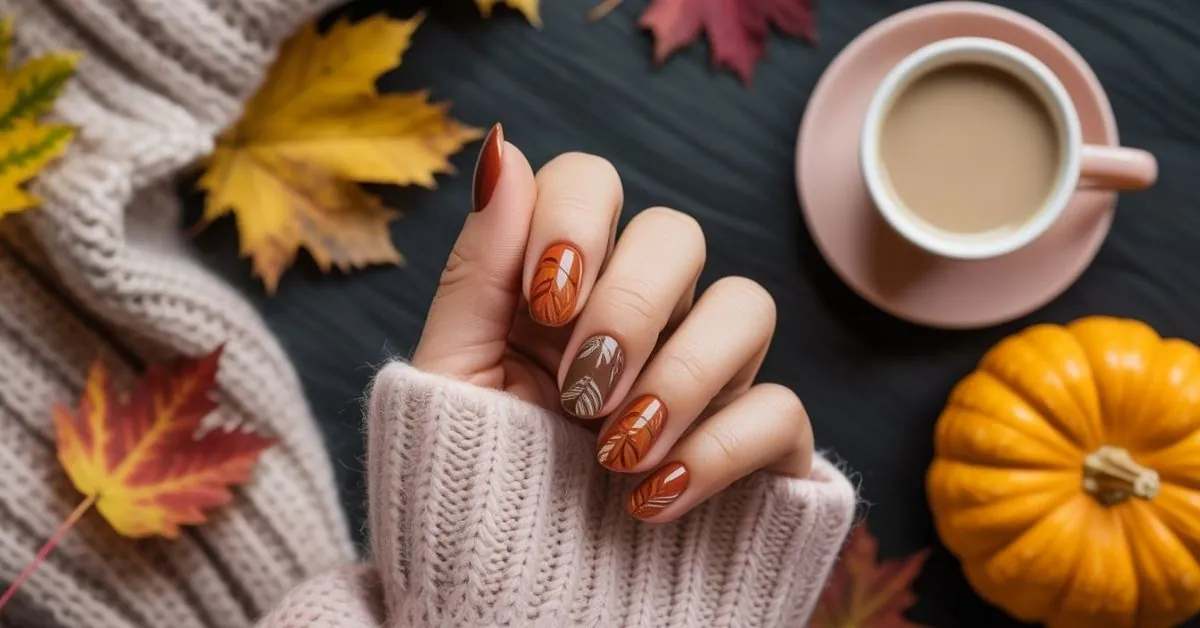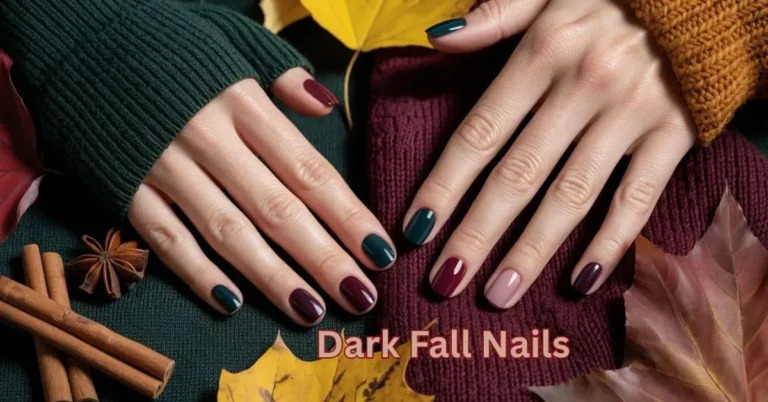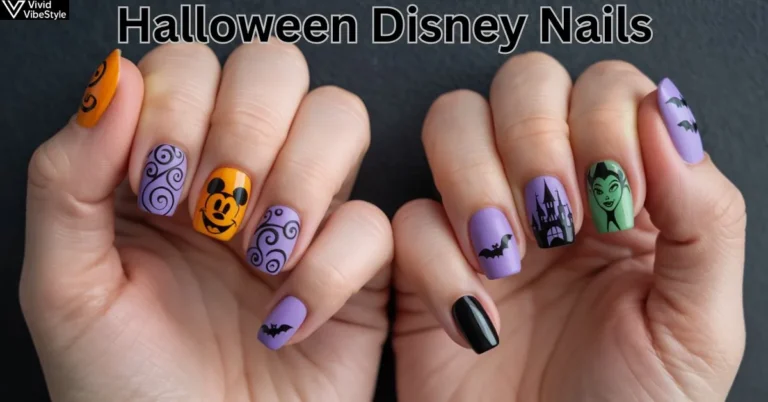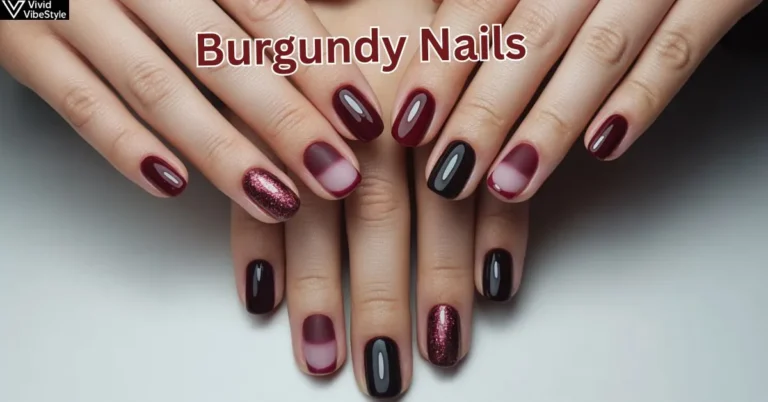Fall Gel Nails: Ultimate Guide to Autumn Manicure Trends, Colors & Long-Lasting Designs
Your summer bright are fading, and suddenly your neon pink gel manicure feels completely out of season. As leaves turn golden and temperatures drop, your nails deserve a seasonal refresh that matches the cozy aesthetics of autumn. This disconnect between your manicure and the world around you isn’t just about vanity it’s about expressing yourself through thoughtful style choices that align with the season.
The frustration deepens when you scroll through social media and see everyone sporting gorgeous fall gel nails in burnt oranges, deep burgundies, and rich chocolates while your outdated summer shades make you feel behind the trend curve. You want that perfect autumn nail look that lasts through pumpkin patches, holiday gatherings, and sweater weather without chipping or fading. The pressure to stay current with seasonal nail trends while maintaining healthy, strong nails can feel overwhelming.
Fall gel nails offer the perfect solution combining long-lasting wear with the season’s most flattering colors and designs. This comprehensive guide reveals everything you need to know about choosing fall nail colors, applying gel polish correctly, creating stunning autumn nail art, and maintaining your manicure throughout the season. Whether you’re a DIY enthusiast or salon regular, you’ll discover professional techniques for achieving Instagram-worthy fall nails that capture the essence of autumn while keeping your nails healthy and beautiful.
What Makes Fall Gel Nails Different From Regular Seasonal Manicures?
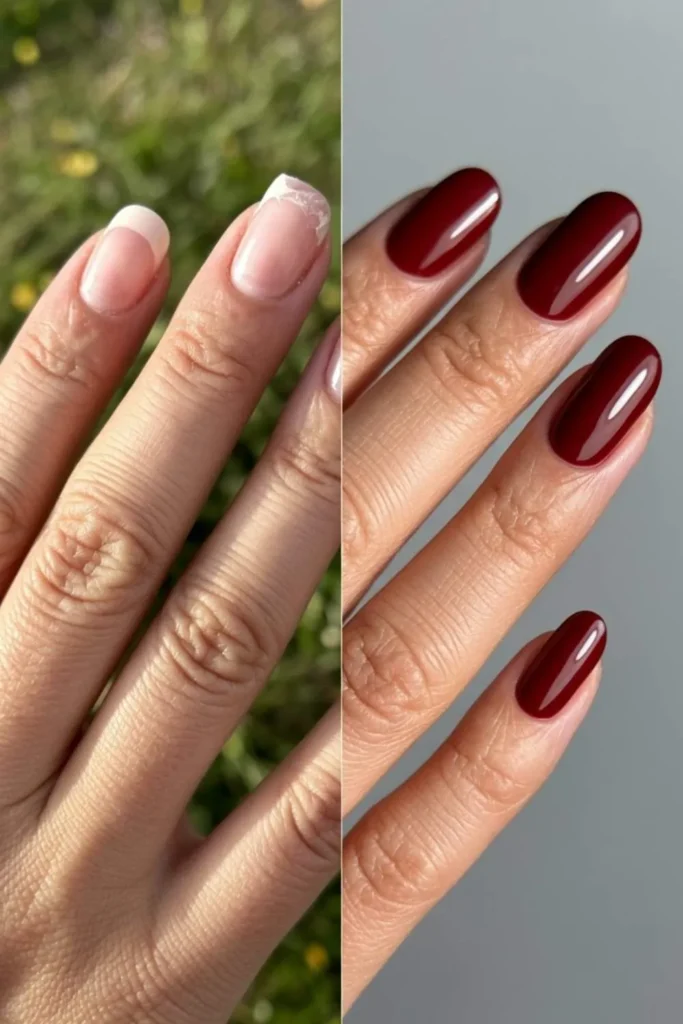
Fall gel nails stand apart from standard polish because they combine UV-cured technology with seasonally appropriate aesthetics. The gel nail system uses photoinitiators that harden under LED or UV light, creating a durable finish that withstands autumn activities like apple picking, outdoor festivals, and frequent hand washing during cold season. Unlike traditional nail polish, which chips within days, gel manicures maintain their glossy appearance for 2-4 weeks.
The chemistry behind gel nails involves oligomers and monomers that cross-link when exposed to specific light wavelengths. This molecular bonding creates a protective shield over your natural nails, preventing damage from harsh fall weather conditions. Cold air and indoor heating rob moisture from your hands and nails, but the sealed gel layer acts as a barrier against environmental stressors that typically cause brittleness during autumn months.
Autumn gel nail designs also differ in color psychology and aesthetic choices. Fall palettes embrace warm undertones burnt orange, terracotta, burgundy, deep plum, and chocolate brown that complement the season’s natural landscape. These earth-tone nail colors contain pigments that look richer and more sophisticated than summer’s pastels or winter’s jewel tones. The fall color palette for nails reflects the transition from bright, carefree summer energy to cozy, introspective autumn vibes.
Texture plays a crucial role too. Fall nail trends often incorporate matte finishes, metallic accents, and dimensional elements like chrome powder or glitter topcoats that mimic falling leaves or harvest themes. The versatility of gel polish formulas allows nail technicians and home users to layer effects that simply aren’t possible with regular lacquer, creating depth and visual interest that captures autumn’s complex beauty.
See More : Dark Green Almond Nails: The 2025 Trend That’s Taking Over Social Media
Why Are Gel Nails the Best Choice for Fall Season?
Gel nails excel during fall because they withstand temperature fluctuations better than traditional polish. Autumn brings constant shifts between chilly outdoor air and heated indoor spaces, causing regular nail polish to expand and contract, leading to premature chipping. The flexible yet durable nature of cured gel maintains its integrity despite these thermal changes, keeping your fall manicure pristine through seasonal transitions.
The longevity factor becomes especially valuable during busy fall months filled with holidays, travel, and social events. A properly applied gel manicure lasts 14-21 days on average, eliminating the need for weekly touch-ups that traditional polish requires. This extended wear time means you can get your fall gel nails done before Thanksgiving and still have flawless color for family photos and holiday gatherings weeks later.
Gel polish also offers superior color saturation compared to regular formulas. Fall nail shades like deep red, forest green, and navy blue appear more vibrant and true-to-color in gel formulations because the pigment particles suspend evenly throughout the resin base. Single-coat coverage becomes possible with many gel brands, saving time during application while delivering professional results that showcase autumn’s rich color story beautifully.
Protection for your natural nails matters more during fall when cold weather compromises nail health. The gel coating seals the nail plate, preventing moisture loss and reducing breakage risk. Many modern gel formulas now include strengthening ingredients like calcium and biotin that support nail growth while providing that coveted glossy finish that makes fall gel nails photograph beautifully against autumn backdrops.
Which Fall Nail Colors Dominate 2025 Trends?
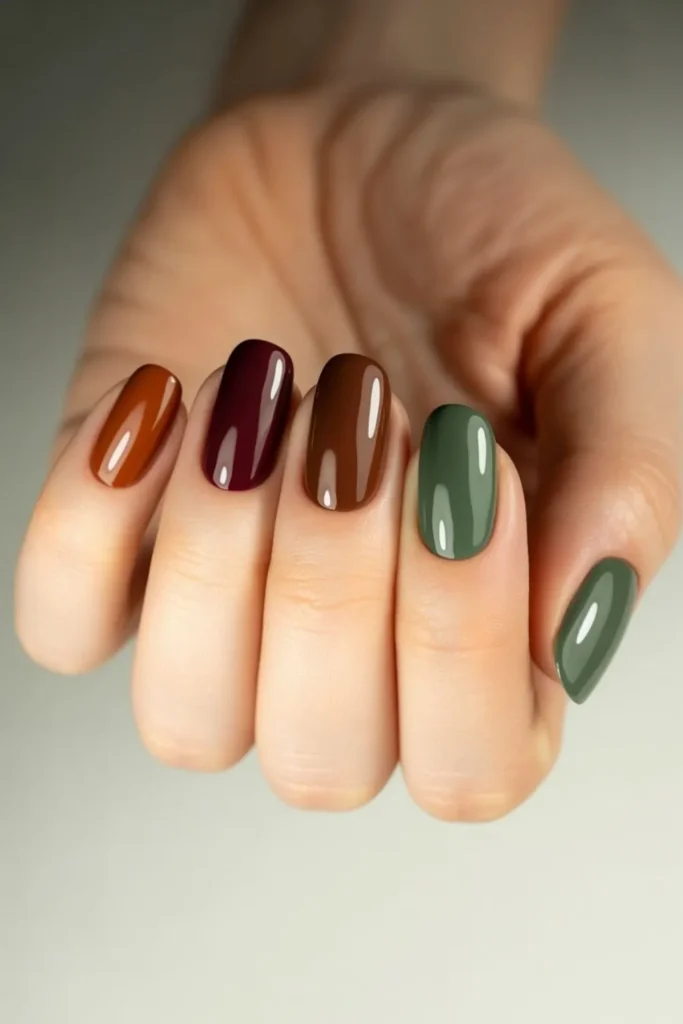
Burnt sienna emerges as the breakout star of 2025 fall nail colors, offering a sophisticated alternative to traditional orange. This terracotta-adjacent shade balances warmth with earthiness, complementing all skin tones while evoking the essence of autumn leaves. Beauty influencers and celebrity manicurists consistently feature this versatile hue in their fall gel nail collections, pairing it with gold foil accents or matte topcoats for dimensional interest.
Deep plum and wine burgundy continue their reign as quintessential autumn nail shades. These berry-toned colors transition seamlessly from October through December, working equally well for casual weekend outings and formal holiday events. The richness of plum gel polish provides depth without appearing too dark, while burgundy nails offer timeless elegance that never feels dated or overly trendy.
Chocolate brown has revolutionized fall nail trends for 2025, moving beyond basic brown into complex formulations with red undertones, caramel highlights, or metallic shimmer. This neutral nail color pairs effortlessly with autumn wardrobes dominated by sweaters, boots, and layered textures. Professional settings particularly favor brown gel nails because they appear polished and intentional without drawing excessive attention.
Forest green and emerald shades represent the unexpected twist in 2025’s fall color palette. These jewel-toned greens reference evergreen trees and moody autumn forests, offering a fresh alternative to predictable reds and oranges. When formulated as gel polish, these greens achieve stunning opacity and dimension, especially when topped with gold chrome powder or paired with nude accent nails for contrast.
Muted sage and olive green round out the fall gel nail spectrum, appealing to minimalists who prefer subtle seasonal nods. These dusty green shades evoke dried herbs and prairie landscapes, creating an understated autumn aesthetic that feels modern and curated. The muted quality photographs exceptionally well, making these shades favorites for social media content creators and lifestyle bloggers.
See More : Black French Tip Nails: The Ultimate Guide to 2025’s Most Sophisticated Edge
How Do You Prepare Natural Nails for Fall Gel Application?
Proper nail preparation determines whether your fall gel nails last three days or three weeks. Start by removing existing polish with an acetone-based remover, ensuring no residue remains on the nail plate. Old polish creates a barrier that prevents proper gel adhesion, leading to premature lifting and disappointing wear time. Use lint-free wipes rather than cotton balls to avoid leaving fibers on the nail surface.
Cuticle care ranks as the most overlooked yet critical step in gel nail prep. Apply cuticle oil and let it absorb for 2-3 minutes, then gently push back cuticles with a wooden stick or metal pusher. Never cut living cuticle tissue, as this creates entry points for bacteria and compromises the seal between gel and skin. The goal is creating a clean canvas where gel polish can bond directly to the nail without touching skin, which causes lifting.
Nail shaping requires thoughtful consideration during fall months. Square nails and squoval shapes (square with rounded corners) provide maximum strength and surface area for gel application, making them ideal for autumn activities. Almond and coffin shapes offer elegance but require longer nails that may be impractical for fall tasks like cooking, crafting, or outdoor activities that could cause breakage.
Buffing the nail surface creates microscopic grooves that help gel polish grip effectively. Use a 180-grit buffer in gentle, consistent strokes across the entire nail plate never saw back and forth aggressively, which generates heat and damages the nail. The surface should appear slightly matte, not shiny, indicating you’ve removed the natural oils and created optimal texture for gel bonding.
Dehydration and pH balancing complete professional-level prep. Apply a nail dehydrator or pH bonder to remove remaining oils and moisture that interfere with gel adhesion. These products adjust the nail’s acidity level, creating an ideal environment for the base coat to form strong molecular bonds. Skip this step and you’ll likely experience lifting within days, especially around the cuticle area where natural oils concentrate.
What Base Coat Techniques Ensure Long-Lasting Fall Gel Nails?
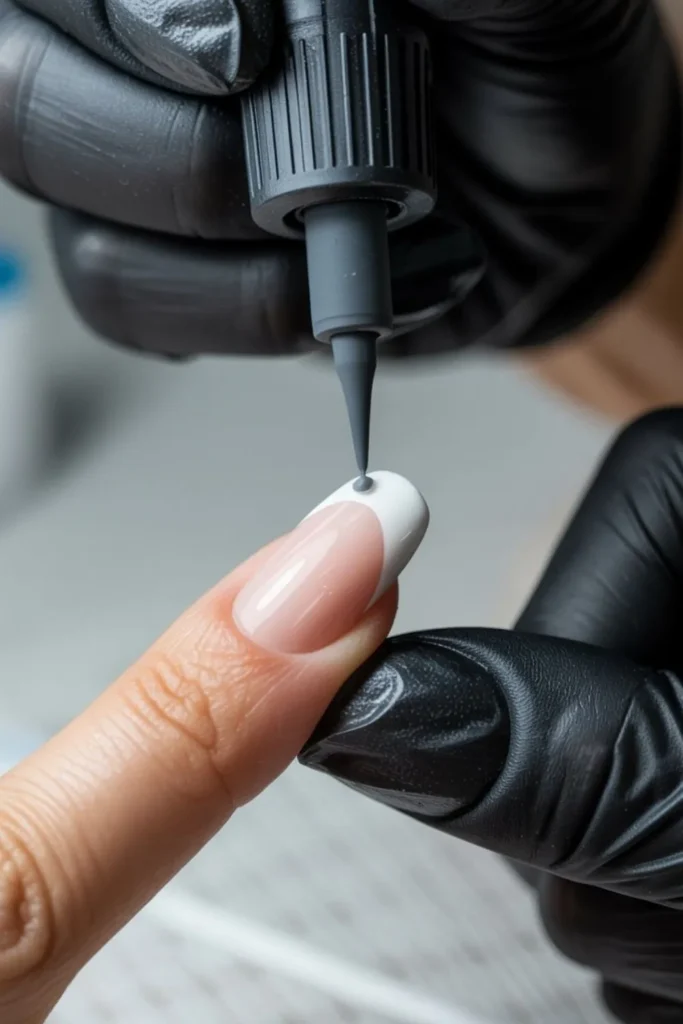
Base coat selection dramatically impacts your fall gel nails durability and health. Rubber base gels provide flexibility that moves with your natural nail, preventing cracks and chips during autumn activities. These formulas contain elastic polymers that absorb impact, making them superior for anyone with active lifestyles involving outdoor fall activities, crafting, or seasonal decorating that stresses nails.
Thin application matters more than most people realize. A common mistake involves applying thick base coat layers, thinking more product equals better protection. Actually, thin coats cure more completely under LED lamps, creating stronger bonds. Apply your base gel in a single, even stroke from cuticle to free edge, capping the tip by running the brush along the nail edge to seal it fully.
Cap the free edge with every gel layer base, color, and top coat. This technique involves painting the brush horizontally across the nail tip, sealing the edge where chipping typically begins. Professional nail technicians swear by this method for extending gel manicure longevity, especially important during fall when you’re reaching into bags, pockets, and gloves that create friction against nail tips.
Curing time shouldn’t be rushed despite the appeal of quick results. Under-cured base coat remains slightly tacky beneath the surface, compromising the entire gel nail structure. Follow your gel brand’s specific recommendations typically 30-60 seconds under LED or 2 minutes under UV and invest in a quality nail lamp with adequate wattage to ensure complete polymerization of every layer.
Avoid skin contact by keeping base gel slightly away from cuticles and sidewalls. Gel polish that touches skin creates an automatic lifting point as natural oils break down the bond. Leave a hairline gap (about 1mm) around all edges, which will be imperceptible once you apply color coats but significantly improves wear time by preventing moisture from seeping under the gel layers.
See More : Chocolate Brown French Tips: 2025’s Ultimate Sophisticated Manicure Guide
How Should You Apply Fall Color Gel Polish for Optimal Results?
Color application transforms simple gel nails into stunning fall nail art. Begin with thin, controlled coats rather than attempting full coverage in one layer. Pigmented fall shades like burgundy, chocolate brown, and deep green may require 2-3 thin coats for opacity, but this approach prevents bubbling, wrinkling, and uneven curing that plague thick applications.
Brush technique separates amateur from professional results. Place the gel polish brush near the cuticle (without touching skin), then push slightly toward the cuticle before pulling down toward the free edge in one smooth motion. This creates even color distribution without flooding the cuticle area, which causes smudging and premature lifting of your fall gel nails.
Capping remains essential with color coats too. After painting the nail surface, run your brush horizontally across the free edge to seal color onto the tip. This step prevents the dreaded “tip wear” where gel polish fades from nail edges before the rest of the manicure shows aging, particularly important for darker fall colors that show wear more obviously than lighter shades.
Cure between coats according to manufacturer specifications. Some gel brands require 30 seconds per coat, while others need 60 seconds. Insufficient curing between color layers leads to wrinkling, where the top surface cures but underlying gel remains liquid, creating rippled textures that ruin your fall manicure’s smooth finish. Write down your specific gel polish brand’s timing to avoid guesswork.
Clean flash properly between curing sessions. The tacky inhibition layer that forms on cured gel helps subsequent layers bond, so don’t remove it until you’ve applied all color coats. However, if you accidentally touch uncured gel and create a fingerprint or smudge, you must remove that section completely with isopropyl alcohol before applying the next layer, or the flaw will remain visible through your entire fall gel nail design.
What Are the Most Popular Fall Gel Nail Art Designs for 2025?
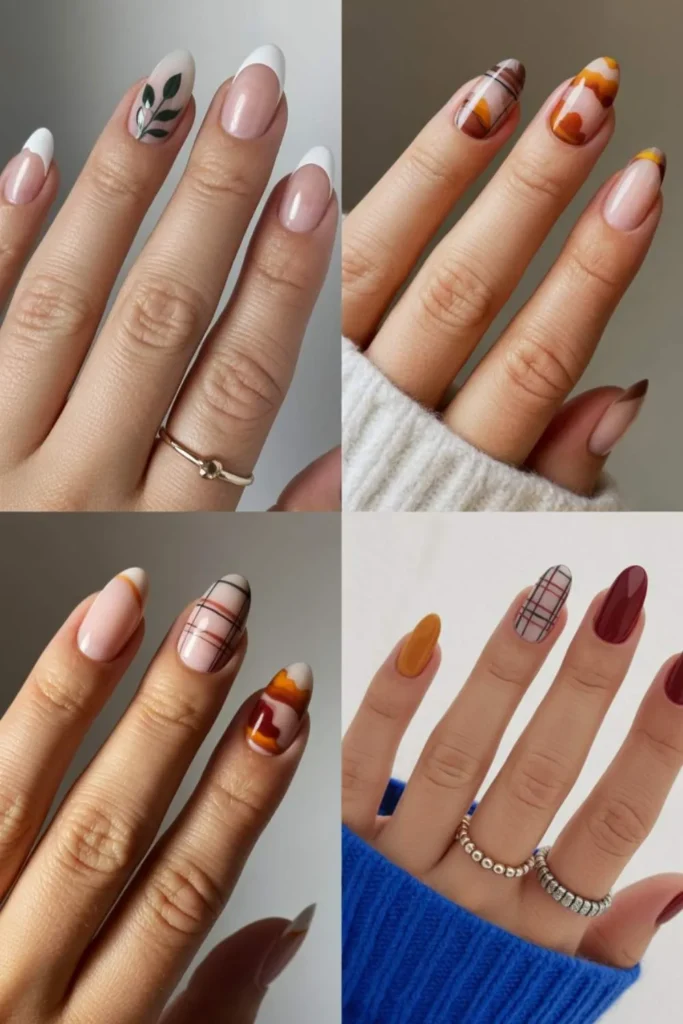
Minimalist fall designs dominate 2025 trends, featuring single accent nails with autumn leaves, pumpkins, or abstract art while keeping remaining nails in solid fall colors. This approach balances seasonal spirit with sophistication, avoiding the overwhelming busy-ness that full-nail patterns create. A single burnt orange nail with a delicate gold leaf accent paired with chocolate brown on other fingers exemplifies this refined aesthetic.
Abstract autumn landscapes have exploded in popularity, featuring watercolor effects created by blending multiple fall gel shades directly on the nail. Using a thin nail art brush or dotting tool, artists blend terracotta, mustard yellow, burnt sienna, and deep red to create gradient effects resembling sunset skies or mountainous horizons. These designs feel artistic and unique while maintaining the warm color palette essential to fall nail trends.
Plaid patterns and sweater textures translate surprisingly well to gel nails, evoking cozy autumn fashion. Nail technicians create these looks using thin striping brushes and multiple fall colors in burgundy, forest green, navy, and cream. The dimensional quality of gel polish allows for layered effects that mimic woven fabric textures, especially when sealed with a matte top coat for an authentic textile appearance.
Chrome accents and metallic foils add luxury to simple fall gel nails. Copper chrome powder, bronze flakes, and gold leaf complement autumn’s natural color story while providing eye-catching dimension. These elements work particularly well on accent nails or as French tip alternatives, where metallic tips replace traditional white for an updated take on classic nail designs.
Negative space designs incorporate bare nail sections into fall patterns, creating modern looks that feel less heavy than fully painted nails. This technique might involve geometric shapes in fall colors that leave portions of the natural nail visible, or outlined autumn motifs where burnt orange gel draws leaf shapes without filling them in completely. The breathing room created by negative space keeps fall nail art from appearing too dense or overwhelming.
See More : 75+ Creative Nail Ideas to Transform Your Manicure Game in 2025
Which Top Coat Options Work Best for Fall Gel Nails?
Glossy top coats remain the standard for fall gel nails, providing the signature shine that makes gel manicures so appealing. High-quality glossy toppers contain UV filters that prevent color fading and protect pigmented fall shades from dulling over time. Apply in the same thin, capped fashion as other gel layers, ensuring complete coverage over color and nail edges for maximum protection and shine.
Matte top coats have revolutionized fall nail aesthetics, offering velvety finishes that perfectly complement autumn’s cozy textures. Matte gel works exceptionally well with burgundy, chocolate, forest green, and burnt orange, creating sophisticated looks that photograph beautifully. The lack of shine prevents reflective glare in photos while adding unexpected elegance to simple solid color manicures or complex nail art designs.
No-wipe top coats streamline the finishing process by eliminating the tacky inhibition layer that typically requires removal with alcohol. These formulas cure to a completely smooth finish without residue, saving time and reducing the risk of accidentally dulling your shine by wiping too aggressively. They’re particularly valuable for DIY gel nail enthusiasts who want salon-quality results with fewer steps and materials.
Builder gel top coats add strength and thickness ideal for fall months when nails face increased stress from cold weather and indoor heating. These thicker formulas slightly extend the nail and create a protective dome over color, making them perfect for anyone with naturally thin or flexible nails prone to breaking during autumn activities. The added structure helps fall gel nails withstand impacts that would crack thinner applications.
Quick-dry top coats offer convenience without sacrificing quality, curing in 30 seconds or less under LED lamps. These efficient formulas suit busy schedules typical of fall’s packed social calendar, reducing overall manicure time while still providing durable, glossy finishes. However, verify compatibility with your specific gel polish brand, as some quick-dry toppers may interact poorly with certain color formulas, causing shrinkage or dulling.
How Can You Create Ombré Fall Gel Nails at Home?
Ombré gel nails showcase fall color transitions beautifully, blending shades like burnt orange into deep burgundy or mustard yellow into chocolate brown. Begin by applying your lighter gel color as the base, curing it completely according to manufacturer instructions. This foundation ensures your gradient has a solid starting point and prevents muddy color mixing that occurs when blending over uncured gel.
Sponge application creates the smoothest ombré effects. Apply small amounts of your two chosen fall gel colors onto a makeup sponge the lighter shade on top, darker on bottom. Dab the sponge onto your nail in a bouncing motion, working from cuticle to tip, allowing colors to meet and blend in the middle. The sponge’s texture naturally diffuses the gel polish, creating seamless gradients impossible to achieve with brushes alone.
Blending technique requires patience and light pressure. After each sponge application, cure the gel for just 15-20 seconds (a “flash cure”), which sets the color without fully hardening it. This allows you to build up the gradient gradually through multiple applications, achieving smooth transitions between autumn shades. Rush this process and you’ll create stark color lines rather than soft blends.
Cleanup becomes crucial with ombré methods since sponging often applies gel beyond nail borders onto surrounding skin. Use a small cleanup brush dipped in alcohol or acetone to remove excess gel polish from cuticles and sidewalls before final curing. Alternatively, apply liquid latex or petroleum jelly around nails before starting, creating a barrier you can peel away after finishing your fall ombré design.
Sealing ombré nails requires a quality top coat applied generously to smooth out any texture created by sponge application. The top coat fills in microscopic peaks and valleys left by the dabbing motion, creating a glass-like finish that makes your gradient appear flawless. Two thin top coat layers work better than one thick application, ensuring complete coverage and maximum shine for your fall gel nail art.
What Tools Do You Need for Professional Fall Gel Nails at Home?
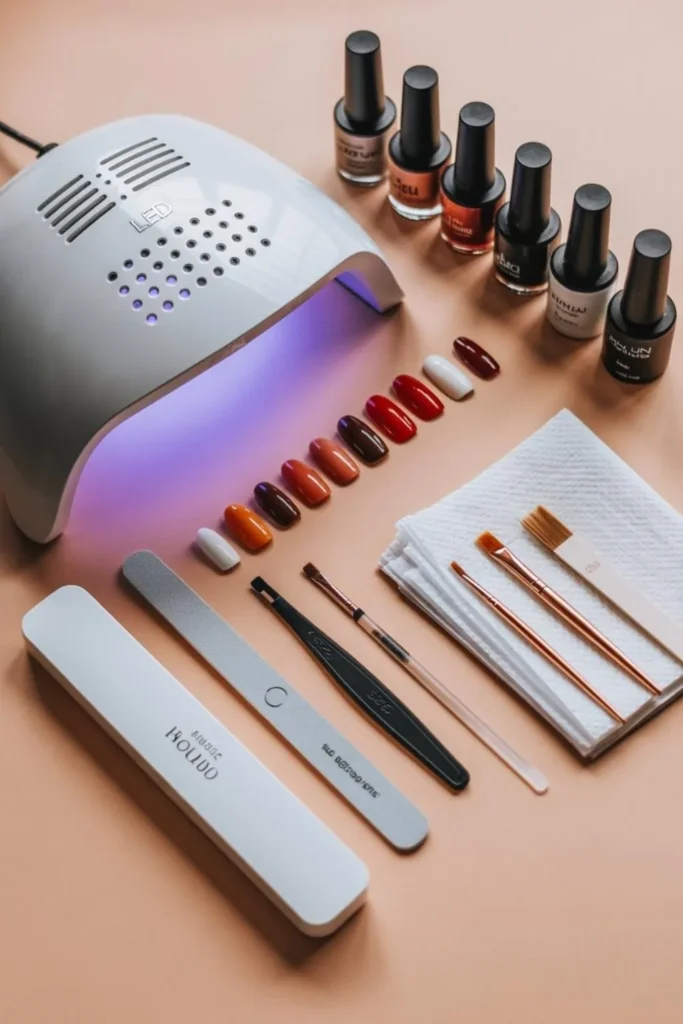
LED nail lamps rank as the most critical investment for DIY gel nails, with minimum 36-watt power recommended for complete curing. Modern LED lamps cure most gel formulas in 30-60 seconds compared to older UV lamps requiring 2-3 minutes. Look for lamps with automatic sensors, timer settings, and sufficient interior space to cure all five fingers simultaneously, streamlining the fall gel nail application process.
Quality gel polish from reputable brands ensures better color payoff, longevity, and nail health compared to budget options. Professional-grade gel formulas contain higher-quality resins and pigments that cure consistently and resist yellowing over time. For fall nails, invest in a curated palette including burnt orange, burgundy, chocolate brown, forest green, and a versatile nude for accent designs and French tips.
Nail preparation tools include cuticle pushers, nail files (180-grit for shaping, 240-grit for smoothing), buffers, and nail clippers. Stainless steel implements last longer and sterilize more effectively than plastic alternatives. A nail drill offers advanced options for removing previous gel applications efficiently, though manual methods using acetone and foil wraps work perfectly well for home users creating fall gel nails.
Application brushes beyond those attached to gel polish bottles expand your nail art capabilities dramatically. Invest in thin striping brushes for plaid patterns and abstract designs, dotting tools for creating polka dots and floral elements, and fan brushes for applying chrome powder or glitter to your fall gel manicures. Clean these tools with alcohol immediately after use to prevent gel from hardening on bristles.
Finishing supplies complete your home gel nail kit: isopropyl alcohol (99% concentration preferred), lint-free wipes, cuticle oil, and a nail dehydrator or pH bonder. Don’t forget acetone for removal and cotton pads or remover wraps for efficient soak-off. A hand cream enriched with shea butter or vitamin E helps combat fall’s drying effects, keeping skin hydrated around your beautiful fall gel nails.
See More : Rust Orange Nails: The Ultimate 2025 Fall Trend Guide
How Do Fall Weather Conditions Affect Gel Nail Longevity?
Cold temperatures cause natural nails to contract slightly, while heated indoor spaces make them expand. This constant flexing creates microscopic stress points in gel coatings, potentially leading to cracks or lifting if the gel formula lacks flexibility. Rubber base gels and flexible top coats specifically address this challenge, maintaining their integrity despite thermal cycling common during fall months.
Dry air dominates autumn environments, depleting moisture from nails and surrounding skin. Dehydrated nail plates become brittle and prone to breakage, while dry cuticles shrink away from the nail bed, creating gaps where water and bacteria can penetrate beneath gel polish. Combat this by applying cuticle oil twice daily, focusing on the area where gel meets skin to maintain a tight seal throughout your fall manicure’s lifespan.
Increased hand washing during cold and flu season subjects fall gel nails to repeated exposure to water and harsh soaps. While properly cured gel polish resists water damage, poor application or premature removal of the top coat’s protective layer creates vulnerabilities. Always dry hands thoroughly after washing and reapply hand cream to prevent moisture from seeping under gel edges near cuticles and sidewalls.
Indoor heating systems create environmental conditions nearly as harsh as cold weather itself. Central heating drops indoor humidity levels drastically, accelerating moisture loss from nails and skin. This drying effect compounds natural autumn weather challenges, making fall the season when nail health requires the most attention. Using a humidifier in frequently occupied rooms helps maintain atmospheric moisture that benefits both your fall gel nails and overall skin health.
Outdoor activities popular during fall pumpkin picking, hiking, festival attendance expose gel nails to dirt, impact, and friction that test durability. The combination of gel’s hard surface with proper prep and quality top coats generally withstands these challenges well. However, be mindful during activities requiring gloves, as the fabric friction against nail tips can gradually wear down even the most durable gel manicures if gloves are repeatedly donned and removed.
What Are Common Mistakes When Applying Fall Gel Nails?
Over-filing natural nails ranks as the most damaging mistake people make preparing for gel application. Aggressive buffing thins the nail plate, causing pain, sensitivity, and long-term damage that makes future manicures difficult. The goal is creating texture for gel adhesion, not removing layers of healthy nail. Use a gentle 180-grit buffer in light, consistent strokes, stopping once the shiny surface appears matte.
Skipping base coat to save time or product destroys your fall gel nails before they start. Base gel isn’t optional it bonds to the prepared nail surface using different chemistry than color gel, creating the foundation your entire manicure depends on. Without it, color gel adheres poorly, lifts quickly, and often stains natural nails, particularly with deep fall shades like burgundy or forest green that contain strong pigments.
Applying thick coats might seem efficient but guarantees problems. Thick gel layers don’t cure completely, remaining soft in the middle despite appearing hard on the surface. This under-cured gel wrinkles, bubbles, or separates from the nail within days. Always apply thin coats you should see your nail or previous layer through the wet gel building coverage gradually through multiple properly cured layers for lasting fall gel nails.
Neglecting cuticle gaps causes premature lifting as gel polish applied directly onto skin breaks down from natural oils and moisture. Many people apply gel right to the cuticle line thinking it looks fuller, but this technique guarantees failure within 3-5 days. Leave a tiny gap (1mm) between gel and cuticle, which becomes invisible once cured but prevents the flooding and lifting that ruins fall manicures prematurely.
Insufficient curing happens when using incompatible lamps or not following timing guidelines. Some people assume all gel polishes cure at the same rate, but formulations vary significantly. Always cure according to your specific gel brand’s instructions 30 seconds might work for one brand while another requires 60 seconds. Under-cured gel remains tacky beneath the surface, leading to smudging, denting, and poor wear time for your fall gel nails.
How Should You Remove Fall Gel Nails Safely?
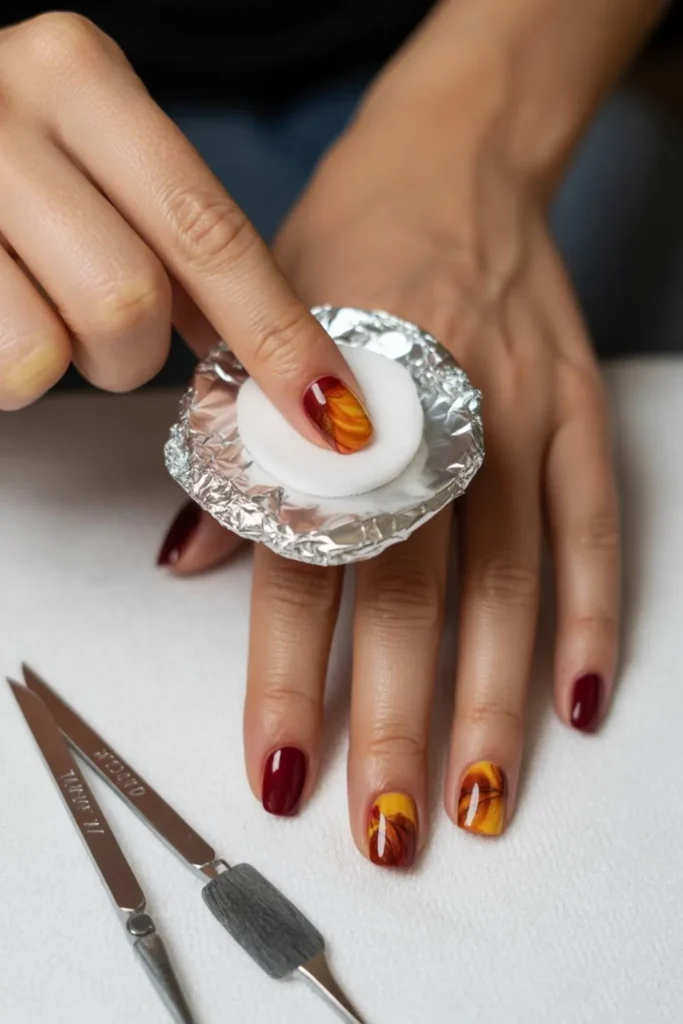
Acetone soaking remains the safest gel removal method when done correctly. Soak cotton pads in pure acetone, place them on nails, then wrap each finger in aluminum foil to prevent evaporation and enhance penetration. Wait 10-15 minutes while acetone breaks down the gel polish molecular structure, softening it for easy removal without forcing or scraping that damages natural nails.
Avoid picking or peeling gel despite the temptation when edges start lifting. Peeling removes layers of your natural nail along with the gel coating, causing significant damage that takes months to repair. These stripped areas appear white, feel rough, and remain vulnerable to breakage. The convenience of quick removal never justifies the lasting harm that picking causes to your nail health and future manicure success.
Gently push softened gel using an orange wood stick or metal pusher after soaking. The gel should slide off easily if adequately softened if you’re scraping aggressively, rewrap and soak longer rather than forcing removal. Work from cuticle toward free edge, using light pressure and stopping if you encounter resistance that indicates the gel needs more acetone exposure time.
Buff residue carefully once bulk gel is removed. A fine 240-grit buffer smooths remaining thin gel patches without aggressive filing that damages natural nails. Use gentle circular motions rather than back-and-forth sawing, focusing only on areas with visible gel residue. Your nails should feel smooth but not paper-thin when finished if you’ve exposed raw nail plate, you’ve buffed too aggressively.
Moisturize immediately after removal since acetone strips natural oils from nails and surrounding skin. Apply generous amounts of cuticle oil to all ten fingers, massaging it into nail plates, cuticles, and sidewalls. Follow with rich hand cream containing shea butter, vitamin E, or jojoba oil. This rehydration step helps nails recover from removal and prepares them for your next fall gel manicure application.
See More : Leopard Print Nails 2025: 25 Fierce Designs & Easy DIY Tutorials That’ll Make You Roar
What Are the Best Fall Gel Nail Colors for Different Skin Tones?
Fair skin tones glow beautifully with deep burgundy, wine red, and rich plum shades that create dramatic contrast without overwhelming delicate coloring. These jewel-toned fall colors provide the depth and richness appropriate for autumn while complementing cool undertones common in lighter complexions. Dusty rose and mauve offer softer alternatives that still capture fall’s essence without appearing too bold.
Medium skin tones have incredible versatility with fall gel colors, looking stunning in both warm and cool shades. Burnt orange, terracotta, and rust complement natural golden undertones beautifully, while chocolate brown, caramel, and bronze create sophisticated, monochromatic effects. Forest green and emerald provide jewel-toned contrast that makes medium skin tones appear luminous and warm.
Olive skin tones particularly shine with earthy fall shades including sage green, olive, moss, and khaki that harmonize with natural green undertones. These colors create cohesive, natural-looking autumn manicures that enhance rather than compete with skin tone. Deep plum, eggplant, and burgundy offer beautiful contrast, while copper and bronze metallics bring out golden highlights in olive complexions.
Deep skin tones carry bold fall colors with stunning impact, making dark gel shades like espresso brown, navy, black cherry, and deep purple appear rich and luxurious. These intense pigments don’t get lost against deeper complexions but instead create beautiful dimension. Burnt orange, rust, and copper provide gorgeous warm contrasts, while metallic gold and bronze chrome add eye-catching brilliance.
Universal fall shades work across all skin tones, making them safe choices when you’re uncertain or want versatile colors. Warm nude, soft taupe, greige (gray-beige), and cinnamon complement everyone while maintaining autumn’s warm aesthetic. These neutral fall colors provide sophisticated bases for nail art or stand beautifully alone for minimalist gel manicures appropriate for professional settings and casual fall activities alike.
How Can You Extend the Wear Time of Your Fall Gel Nails?

Daily cuticle oil application dramatically extends gel nail longevity by maintaining the seal between gel and skin. Apply oil morning and night, massaging it into cuticles, sidewalls, and over the gel surface itself. This prevents the dryness-related shrinking that creates gaps where moisture penetrates, causing lifting. Jojoba oil, vitamin E, and argan oil formulas work particularly well for maintaining fall gel nails through autumn’s harsh conditions.
Wear gloves during activities involving water, cleaning products, or physical labor that stresses nails. Even cured gel can degrade when repeatedly exposed to harsh chemicals found in household cleaners, dish soap, and certain beauty products. Gloves provide a protective barrier that keeps your fall gel manicure looking fresh while preventing the microscopic damage that accumulates from daily tasks and shortens wear time.
Avoid extreme temperatures whenever possible, particularly sudden shifts from hot to cold. While this isn’t always controllable during fall months, be mindful of activities like moving between heated buildings and cold outdoor spaces repeatedly. Give your hands time to adjust gradually rather than shocking them with temperature extremes that cause gel to expand and contract rapidly, stressing the molecular bonds holding your manicure together.
Top coat refreshers applied at home between salon visits can extend gel shine and protection. Some brands offer lightweight toppers designed to layer over existing gel manicures, restoring gloss and adding a protective layer without requiring full removal and reapplication. This maintenance step works particularly well around day 10-14 when your fall gel nails remain structurally sound but have lost some initial shine from daily wear.
Proper removal timing prevents damage that shortens future gel wear times. Don’t wait until your gel manicure has lifted extensively or grown out excessively before removing it. The optimal removal window is 14-21 days, when gel has maintained its integrity but natural nail growth creates visible gaps. Wearing gel too long allows moisture and bacteria to colonize lifted areas, compromising nail health and making your next fall gel manicure less durable.
See More : Almond-Shaped Fall Nails: The Ultimate Guide to 2025’s Most Coveted Nail Trends
What Fall Nail Art Techniques Work Best for Beginners?
Single accent nails provide the easiest entry into fall nail art, requiring minimal skill while delivering maximum impact. Paint nine nails in a solid fall color like burgundy or chocolate brown, then create a simple design on one accent finger perhaps a gold stripe, small dot pattern, or single autumn leaf using a thin brush. This approach keeps designs manageable while letting you practice nail art techniques without the pressure of executing complex patterns on all ten fingers.
Stamping plates revolutionize fall nail art for beginners by transferring intricate designs instantly. These metal plates feature etched patterns you fill with gel polish, then transfer to nails using a silicone stamper. Autumn-themed stamps featuring leaves, plaid, sweater patterns, and pumpkins let you create professional-looking fall designs in minutes. Seal stamped patterns with gel top coat for integration into your gel manicure rather than leaving them as surface decor.
Dotting tools create endless fall nail art possibilities using only circular motions. These inexpensive implements form perfect dots in varying sizes, allowing beginners to craft polka dot patterns, floral designs, berry clusters, and abstract art without the steady-hand requirements that brush work demands. Arrange dots in burnt orange, mustard yellow, and deep red randomly across a neutral base for easy autumn-themed gel nails anyone can master.
Striping tape eliminates the precision needed for hand-painted lines, creating clean geometric designs and color blocking effects instantly. Apply your base gel color, cure it, then place thin adhesive tape in desired patterns before painting contrasting fall shades in the sections. Remove tape before curing the second color to reveal crisp lines that look professionally executed, perfect for plaid patterns or modern minimalist designs.
Gradient sponging requires no artistic ability beyond dabbing motions, making it ideal for beginners wanting dimensional fall gel nails. Choose two or three coordinating autumn colors, apply them side-by-side on a makeup sponge, and bounce the sponge onto nails to blend shades naturally. The forgiving nature of this technique means imperfect applications still create beautiful results, and mistakes easily blend into the overall gradient effect rather than standing out as obvious errors.
Which Fall Gel Nail Shapes Flatter Different Hand Types?

Almond-shaped nails elongate short fingers beautifully while maintaining practical length for fall activities. This tapered shape that comes to a soft point creates the illusion of length without the fragility of extreme stiletto styles. Almond nails showcase fall gel colors elegantly, providing enough surface area for intricate nail art while remaining functional for everyday tasks like typing, cooking, and outdoor autumn adventures.
Square nails with slightly rounded edges (squoval) suit wide nail beds perfectly, creating balanced proportions that prevent nails from appearing stubby. This shape offers maximum strength and durability critical during fall months when nails face increased stress from cold weather and seasonal activities. The flat tip provides excellent canvas space for French tips, geometric designs, and negative space art in trendy fall colors.
Oval nails universally flatter most hand types, creating soft, feminine aesthetics that complement both casual and professional settings. This classic shape follows the natural nail bed curve, extending it gracefully without sharp angles or extreme points. Oval-shaped gel nails in burgundy, chocolate, or deep plum appear timeless and sophisticated, perfect for women wanting elegant fall manicures that transition seamlessly between different occasions and outfits.
Coffin nails (ballerina shape) create dramatic impact for those with naturally longer fingers and nail beds. This squared-off tapered shape requires length to execute properly but provides exceptional surface area for complex fall nail art including ombré, landscapes, and detailed patterns. The modern, edgy aesthetic pairs particularly well with matte top coats and bold fall colors like forest green or black cherry.
Short round nails serve practical lifestyles while still showcasing beautiful fall gel colors. This conservative shape follows the fingertip’s natural curve at a shorter length, ideal for professionals, parents, or anyone whose daily activities make longer nails impractical. Deep fall shades and simple nail art on short nails appear chic and intentional rather than boring, proving that elegant autumn manicures don’t require extreme length or elaborate designs.
See More : 50+ Pumpkin Spice Nails That Perfectly Capture Autumn’s Cozy Elegance in 2025
How Do You Maintain Healthy Nails Between Fall Gel Applications?
Recovery periods between gel manicures give natural nails time to breathe and repair, though modern gel formulas no longer require mandatory breaks like older versions did. If you notice thinning, peeling, or brittleness, take 1-2 weeks off from gel while treating nails with strengthening products. Apply nail hardener containing calcium or keratin daily, followed by cuticle oil to support healthy regrowth during your break from fall gel nails.
Biotin supplements support nail health from within, though results require consistent use over 3-6 months to become visible. This B-vitamin strengthens the keratin infrastructure that forms nails, potentially reducing breakage and improving thickness. Combine biotin (2,500-5,000 mcg daily) with a balanced diet rich in protein, omega-3 fatty acids, and iron for comprehensive nutritional support that benefits not just nails but hair and skin too.
Hydration extends beyond topical products to your overall water intake, which affects nail moisture and flexibility. Dehydration causes nails to become brittle and prone to cracking especially problematic during fall when environmental factors already deplete moisture. Aim for adequate daily water consumption and use a humidifier in your home to counteract the drying effects of heating systems on your nails and skin.
Gentle filing techniques prevent damage when shaping nails between gel applications. Always file in one direction rather than sawing back and forth, which creates microscopic tears in the nail plate that lead to splitting and peeling. Use a fine-grit file (240 or higher) and work slowly, checking progress frequently to avoid over-filing that thins nails and makes them vulnerable to damage during your next fall gel manicure.
Protection from chemicals means wearing gloves when using cleaning products, doing dishes, or working with substances that degrade nail health. Even brief exposures to harsh detergents, bleach, and solvents strip natural oils from nails and surrounding skin, making them dry and brittle. This protection becomes especially important during fall when nails already face environmental stresses from cold weather and low humidity levels.
What Are the Latest Fall Gel Nail Technology Innovations for 2025?

HEMA-free gel formulas address sensitivity concerns that previously prevented some people from enjoying gel manicures. HEMA (hydroxyethyl methacrylate) causes allergic reactions in certain individuals, leading to itching, redness, and nail separation. The new HEMA-free gel polishes use alternative monomers that cure just as effectively while dramatically reducing allergy risk, making fall gel nails accessible to people who previously couldn’t wear them safely.
Soak-off builder gels combine the strength of traditional hard gels with the easy removal of regular gel polish. These hybrid formulas let you build length, repair cracks, and add structural reinforcement to weak nails all while remaining removable with acetone like standard gel polish. This innovation proves particularly valuable during fall when nails need extra strength but you still want the flexibility to change autumn colors seasonally.
Quick-cure formulas reduce application time significantly, with some new gel brands curing completely in just 15 seconds under advanced LED lamps. These efficient systems maintain color quality and durability while cutting total manicure time in half. The technology relies on optimized photoinitiator combinations that respond more rapidly to LED wavelengths, perfect for busy individuals wanting gorgeous fall gel nails without extended salon appointments.
Color-changing gels respond to temperature, creating dynamic fall nail designs that shift between shades as you move between indoor and outdoor environments. These thermal gel polishes might transition from burnt orange in warm spaces to deep burgundy in cold, adding interactive elements to your autumn manicure. The novelty factor makes these perfect conversation starters at fall gatherings and holiday events.
Vitamin-infused gel systems incorporate strengthening ingredients directly into base coats and gel formulas, supporting nail health during wear rather than after removal. These advanced products contain keratin, calcium pantothenate, biotin, and antioxidants that penetrate the nail plate during the weeks you wear your gel manicure, theoretically improving nail condition rather than simply protecting it.
While research continues on absorption rates, early results suggest these formulas offer measurable benefits for maintaining strong nails through fall’s challenging conditions.
See More : Cinnamon Nails: The Complete Guide to 2025’s Warmest Nail Trend
FAQ’s
How long do fall gel nails typically last?
Properly applied fall gel nails last 14-21 days on average, though longevity depends on application quality, lifestyle factors, and natural nail growth rate. Activities involving water exposure, physical labor, or frequent hand washing may reduce wear time slightly, while careful maintenance with cuticle oil and gloves during chores extends it. Most people find optimal timing for removal around day 14-18, when the gel remains intact but natural growth creates visible gaps at cuticles.
Can I apply regular polish over gel nails?
You can layer regular nail polish over cured gel if you want to change colors temporarily without committing to a full gel application. The smooth gel surface provides excellent adhesion for traditional polish, which removes easily with regular acetone-free remover without affecting the underlying gel manicure. This technique works well when you want to test fall colors before committing to them in gel form, or need a quick color change for special occasions.
Do gel nails damage your natural nails?
Gel nails themselves don’t inherently damage natural nails when applied and removed correctly. Damage occurs from improper techniques like over-filing during prep, picking off gel instead of soaking, or applying excessively thick layers that require aggressive removal. Following proper application protocols and gentle removal procedures keeps natural nails healthy even with continuous gel wear. Many people actually experience stronger nails from the protective gel coating that prevents environmental damage and breakage.
What’s the difference between gel and acrylic for fall nails?
Gel nails cure under LED or UV light through a chemical process called photopolymerization, creating flexible, glossy finishes ideal for showcasing fall colors. Acrylic nails air-dry after mixing liquid and powder components, resulting in harder, less flexible extensions suitable for dramatic length. Gel offers a more natural appearance and easier removal, making it preferred for fall gel manicures that emphasize color and seasonal designs over extreme length or sculptural effects.
How much do fall gel nails cost at salons?
Gel manicure pricing varies significantly by location and salon prestige, typically ranging from $35-75 for basic applications in most US markets. Nail art, chrome effects, and complex fall designs add $10-30 to base prices. High-end salons in major cities may charge $80-120 for elaborate fall nail art with premium products. DIY gel nails cost $100-200 initially for supplies but reduce per-manicure costs to under $5, making home application economical for regular gel wearers.
Can I use any LED lamp with gel polish?
Not all LED lamps work universally with every gel polish brand due to different wavelength requirements and wattage needs. Most modern gel formulas cure under standard LED lamps (365-405nm wavelength), but some brands require specific lamp compatibility. Always verify your gel polish manufacturer’s recommendations before purchasing a lamp to ensure proper curing. Under-powered lamps may leave gel partially uncured, causing durability issues with your fall gel nails.
Are gel nails safe during pregnancy?
Gel manicures are generally considered safe during pregnancy when performed in well-ventilated spaces with proper technique. The primary concern involves chemical fumes from products, though modern gel formulas emit fewer odors than older versions or acrylic systems. Pregnant individuals should ensure adequate ventilation, avoid breathing directly over products, and inform technicians of their pregnancy so appropriate precautions can be taken. Some choose to avoid gel during the first trimester out of abundance of caution.
How do I prevent gel polish from peeling?
Gel peeling typically results from inadequate nail prep, insufficient curing, or application too close to skin. Prevent peeling by properly dehydrating nails before base coat, applying thin layers that cure completely, leaving small gaps around cuticles, and capping free edges with every gel layer. Using compatible products from the same brand system ensures chemical compatibility that prevents delamination. Daily cuticle oil application maintains the seal between gel and skin, preventing moisture penetration that causes lifting.
Conclusion
Fall gel nails represent more than just seasonal beauty trends they offer practical solutions for maintaining polished, professional appearance through autumn’s unique challenges.
The combination of long-lasting gel technology with carefully chosen fall colors creates manicures that withstand temperature fluctuations, increased hand washing, and busy seasonal schedules while showcasing the rich, warm aesthetic that defines autumn beauty.
From burnt orange and burgundy to chocolate brown and forest green, the fall color palette provides endless opportunities for creative expression that complements both casual weekend activities and formal holiday gatherings.
Success with fall gel nails depends on mastering fundamental techniques including thorough nail preparation, thin gel application, complete curing, and proper maintenance throughout wear. Whether you prefer minimalist solid colors, elaborate nail art designs, or trendy matte finishes, the durability and versatility of gel manicures make them ideal for anyone seeking beautiful nails that last through October’s pumpkin patches, November’s Thanksgiving celebrations, and beyond.
By following the professional methods outlined in this guide and adapting them to your personal style preferences, you’ll achieve salon-quality fall gel nails that capture autumn’s essence while maintaining optimal nail health throughout the season.

